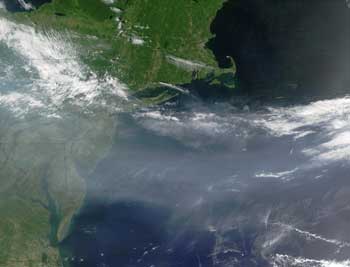[/caption]I bet some of you are fascinated with certain cloud formations. My eldest son once pointed to the sky, excited upon seeing a bunch of clouds taking shape of a menacing dragon. He was however disappointed after a few minutes when the dragon cloud slowly began to deform and fuse with the rest. So how are clouds formed?
First, water evaporates, rises, and fills up the atmosphere. The evaporated water, a.k.a. water vapor then clings to other numerous particles or dust found in the atmosphere. This dust comes from automobiles, fires, volcanoes, bacteria, and sea spray.
As water vapor rises, it cools. Now, the lower the temperature of air, its capacity to hold water vapor (also known as the saturation point of air) also drops.
Eventually, the rising water vapor condenses and forms the structure of the cloud. You can’t however see this structure unless it has its own color. Well, we know that clouds are either white or dark, and that’s why we’re able to see them.
Most clouds are white. That’s because water and ice particles that make up a cloud have just the right amount and sizes to scatter light in all possible wavelengths. When light of practically all wavelengths combine, the result is white light.
However, when too many water and ice particles build up, just like in a storm cloud, much of the scattered light is simply re-scattered into the cloud. In other words, too much particles prevent some of the light from escaping. Hence is the reason why storm clouds are dark.
Try slowly adding milk in water and notice how its color slowly shifts from white to dark as more milk is added.
I’m sure you’ve noticed that clouds easily form on mountains. How are clouds formed on mountains? When a wall of air and water vapor encounters a mountain side, it has nowhere else to go but up the slopes. Well, if you recall, rising water vapor cools and eventually condenses to form clouds.
Thus, mountains don’t have special particles that enhance cloud formation. Rather, it is the barriers that they so form that forces the water vapor to rise and hence develop into cloud structures. A cloud formed due to topographical features is called an orographic cloud.
We’ve got lots of articles about clouds here in Universe Today. For starters, here are two:
Cloud Types
Cirrus Clouds
Here are the links of two more articles from National Oceanic and Atmospheric Administration (NOAA):
Cloud Classifications and Characteristics
Western Region Technical Attachment
Here are two episodes at Astronomy Cast that you might want to check out as well:
Orbit of the Planets, Green Stars, and Oort Cloud Contamination
Sky Surveys

